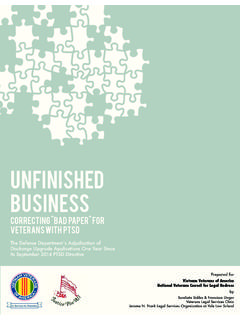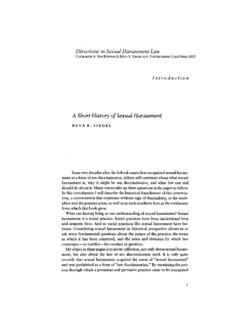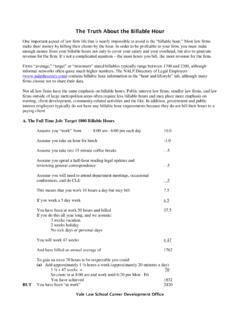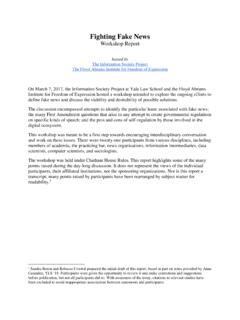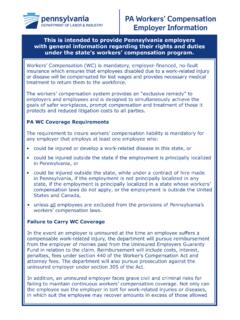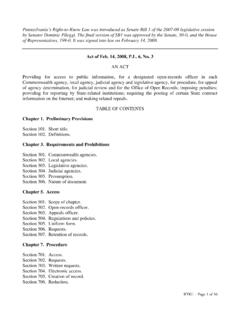Transcription of The Paradox of Declining Female Happiness* - Yale Law School
1 The Paradox of Declining Female Happiness* Betsey Stevenson The Wharton School University of Pennsylvania, CESifo, and NBER Justin Wolfers The Wharton School University of Pennsylvania CESifo, CEPR, IZA and NBER ~jwolfers Abstract By many objective measures the lives of women in the United States have improved over the past 35 years, yet we show that measures of subjective well being indicate that women s happiness has declined both absolutely and relative to men. The Paradox of women s Declining relative well being is found across various datasets, measures of subjective well being, and is pervasive across demographic groups and industrialized countries.
2 Relative declines in Female happiness have eroded a gender gap in happiness in which women in the 1970s typically reported higher subjective well being than did men. These declines have continued and a new gender gap is emerging one with higher subjective well being for men. This draft: October 16, 2008 Keywords: Subjective well being, life satisfaction, happiness, gender, job satisfaction, women s movement. JEL codes: D6, I32, J1, J7, K1 * We would like to thank Amanda Goodall, Christian Holzner, Robert J ckle, Andrew Oswald, Eric Posner, Cass Sunstein, David Weisbach and seminar participants at the American Law and Economics meetings, UC Berkeley, Brigham Young University, University of British Columbia, Case Western Reserve University, CESifo / Munich University, University of Chicago, Conference on Empirical Legal Studies,Cornell Law School , Harvard, Institute for International Economic Studies at Stockholm University, the Kiel Institute, the University of Linz University of Oslo.
3 University of Pennsylvania, , Swedish Institute for Social Research at Stockholm University, , the San Francisco Federal Reserve Bank, for useful comments and discussions. I. Introduction By many measures the progress of women over recent decades has been extraordinary: the gender wage gap has partly closed; educational attainment has risen and is now surpassing that of men; women have gained an unprecedented level of control over fertility; technological change in the form of new domestic appliances has freed women from domestic drudgery; and women s freedoms within both the family and market sphere have expanded. Blau s 1998 assessment of objective measures of Female well being since 1970 finds that women made enormous gains.
4 Labor force outcomes have improved, as women s real wages have risen for all but the least educated women, women s wages relative to those of men have increased for women of all races and education levels, and Female labor force participation has risen to record levels both absolutely and relative to that of men (Blau and Kahn 2007). In turn, better market outcomes for women have likely improved their bargaining position in the home by raising their opportunities outside of marriage. Yet we document in this paper that measures of women s subjective well being have fallen both absolutely and relatively to that of men. While the expansion in women s opportunities has been extensively studied, the concurrent decline in subjective well being has largely gone unnoted.
5 One exception to this is Blanchflower and Oswald (2004), who study trends in happiness in the United States and Britain noting that while women report being happier than men, the trend in white women s happiness in the United States has been negative. We will show in this paper that women s happiness has fallen both absolutely and relative to men s in a pervasive way among groups and that this has occurred through much of the industrialized world. Social changes that have occurred over the past four decades have increased the opportunities available to women and a standard economic framework would suggest that these expanded opportunities for women would have increased their welfare.
6 However, others have noted that with the expansion of opportunities have come costs and that men may have been the beneficiaries of the women s movement. In particular, many sociologists have argued that women s increased opportunities for market work have led to an increase in the total amount of work that women do. Arlie Hochschild s The Second Shift argued that women s movement into the paid labor force was not accompanied by a shift away from household production and they were thus now working a second shift . However, time use surveys do not bear this out. Aguiar and Hurst (2007) document relatively equal declines in total work hours since 1965 for both men and women, with the increase in hours of market work by women offset by large declines in their non market work.
7 Similarly, men are now 2 working fewer hours in the market and more hours in home production. Blau (1998) points to the increased time spent by married men on housework and the decreased total hours worked (in the market and in the home) by married women relative to married men as evidence of women s improved bargaining position in the home. However, it should be noted that Hochschild s argument went beyond counting hours in The Second Shift. Women, she argued, have maintained the emotional responsibility for home and family: a point that is perhaps best exemplified by the familiar refrains of a man helping around the house or being a good dad when babysitting the kids.
8 Thus even if men are putting in more hours, it is difficult to know just how much the burden of home production has shifted, as measuring the emotional, as well as physical, work of making a home is a much more difficult task. A recent paper by Alan Krueger (2007) sheds some light on this issue by examining the degree of pleasantness and unpleasantness in daily activities. Assuming that one s enjoyment of activities has been unchanged, he finds that women s new mix of daily activities leaves them hedonically unchanged. However, men have had a net increase in the pleasantness of activities in their day. Thus, according to Krueger s estimates, between 1966 and 2005 men became better off relative to women.
9 Social and legal changes have given individuals more autonomy over individual and family decision making, including rights over marriage, children born out of wedlock, the use of birth control, abortion, and divorce (Stevenson and Wolfers, 2007). Once again, men may have been able to disproportionately benefit from these increased opportunities: Akerlof, Yellen, and Katz (1996) argue that sexual freedom offered by the birth control pill resulted in women being pressured into having sex outside of marriage and no bargaining power to force a shotgun marriage in the face of an unwanted pregnancy. During this period there have also been large changes in family life.
10 Divorce rates doubled between the mid 1960s and the mid 1970s, and while they have been falling since the late 1970s, the stock of divorced people has continued to grow (Stevenson and Wolfers, 2008). In addition to divorce, there has been an increase in the rate of children born out of wedlock that was concentrated in the 1960s and early 1990s. As a result of increases in both divorce and out of wedlock childbearing by age 15 about half of all children in the US are no longer living with both biological parents (Elwood and Jencks 2001). These changes have, however, disproportionately impacted non white women and white women with less education (Elwood and Jencks 2001; Isen and Stevenson 2008), Both men and women have faced some other challenging societal trends in the past 30 years as well.
